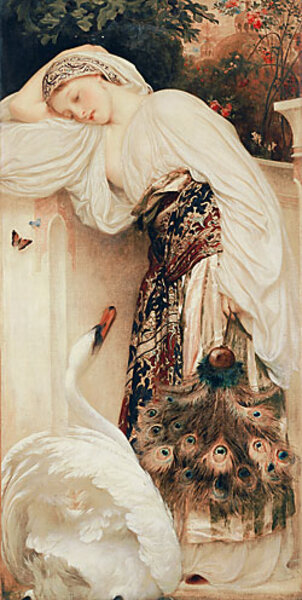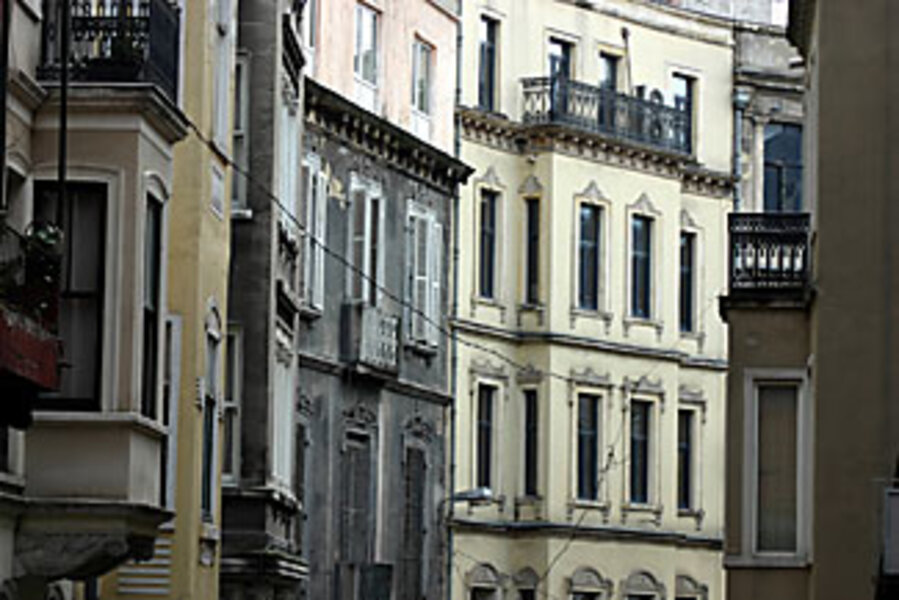Orientalist paintings take a tour of modern Middle East
Loading...
| Istanbul, Turkey
A GAGGLE OF EMIRATI art curators clad head to toe in black hijab paused in front of "Odalisque," British painter Frederick Leighton's sensuous portrait of a partially exposed Oriental beauty gazing indulgently at a long-beaked swan.
Kristine Von Oehsen, the British Council exhibition curator guiding the group, tried to persuade the delegation there was little scandal in the discreet nudity, but the all-female group of Emiratis looked unconvinced.
Such cultural dissonance is part of putting on a show on a topic as controversial as Orientalist painting, then taking it on tour to the Muslim world. This effort at cultural diplomacy by the British Council, the British government's cultural arm, will move to Dubai's Emirati neighbor Sharjah after its show in Istanbul ends in January 2009.
"What makes 'The Lure of the East' different is that the subject is politically and culturally charged, certainly more so than the vast majority of exhibitions that we do," says Christine Riding, the exhibition cocurator and a specialist in 19th-century British art. "The idea of cultural diplomacy or dialogue between the tour venues and their audiences is that much more apparent and resonant."
The 100 or so paintings showcase interpretations of the Orient by a school of mostly British painters traveling in the 19th century throughout the former Ottoman Empire. They immersed themselves in an exotic world far different from the industrial West where they grew up sketching portraits, scenes of everyday life, and landscapes. Often, the subject matter was so unique that they had difficulty rendering it on canvas with the techniques they had learned. Jerusalem's Holy City proved a particular stretch, as centuries of change had stripped it of the biblical landscapes that they imagined Jesus had encountered.
Centuries of confrontation between East and West have embedded distrust on both sides, compounded by the modern experience of imperialism and terrorism. British commentator Yasmin Alibhai Brown visited the show at the Yale Center for British Art in New Haven, Conn., its first foreign location. Writing in the British daily The Independent she noted that "these paintings were always more than paintings." Their executors were a breed that "flourished and prospered during that period of Western hubris and Arab resentment, control and subjugation."
The exhibition was introduced to the Muslim world through Istanbul's private Pera Museum in the chic Beyoglu district that has long represented the West's toehold in the Ottoman Empire. Non-Muslim residents, whether Venetian traders, French diplomats, or Greek artisans, inhabited this commercial and entertainment district across the channel from the seat of the empire at the Topkapi Palace. The Ottomans needed trade with the West, but kept foreigners at arm's length.
In 2003, Beyoglu registered on the casualty sheet of the war against terrorism when a suspected Al Qaeda bombing rocked the British Consulate a week after two nearby synagogues were also struck.
Such precedents were dispelled on the crowded opening night of the "Lure of the East" show this past September as art lovers, local high society, foreign residents, and diplomats mingled in the lavishly appointed foyer of the museum.
"The light and atmosphere in some paintings are exactly what you find when you visit the Grand Bazaar," says Jessica Hound, the British consul general. "It's probably the best place to show in, you get so much more of the atmosphere when you walk in from an Istanbul street into this."
Istanbul's skyscraping minarets, palaces, and Orthodox churches conjure up a romantic cosmopolitanism that have made the city an international destination since Byzantium. Today, it is considered one of the coolest cities as it prepares to become a European Capital of Culture in 2010. Hosting an exhibition that inspired British designer Paul Smith's spring/summer 2009 collection slots into the zeitgeist.
The opening of the Suez Canal and the introduction of steamboat and railway travel enabled a generation of artists to visit the Eastern Mediterranean's great cities. In Istanbul, they mingled with a glamorous aristocratic and international set, such as Halicoo Mirza, a Persian prince of the Qajar dynasty exiled to the Ottoman Empire and one of the few non-Westerners whose portrait is on display.
"It's very interesting for us because it's our culture," says Serpil Erolgil, a photographer pacing through a gallery of Orientalists' portraits. "Most [of the paintings] are from Cairo, but they remind us of our country."
Reviewer Andrew Finkel pointed out in the Turkish newspaper Zaman that showing these works amid the architecture that originally inspired them might come across a bit like selling "coals to Newcastle or, as they say in Persian, like cumin to Kermanshah." But the show also shatters some stereotypes, not least in the work of Henriette Browne, the wife of the French ambassador to Istanbul, who was the first Westerner to paint a harem scene in situ. When she exhibited her work in Paris, their tame domesticity exploded the myths that male painters had perpetuated about the purported debauchery of the harems.
Developing organically as it migrated from London to the United States, Istanbul, and then Sharjah, the exhibition has shed and gained paintings. Upon reaching the end of the road in the United Arab Emirates, it will have traveled from the most cosmopolitan city of the Muslim world to a provincial backwater struggling to establish its name on the art map. Local considerations will come into play and the collection's steamier scenes will be removed to bring it into line with Islamic morality in the conservative Gulf emirate.
"In our museum, we have a special policy," says curator Zakryat Matouk. "We have the culture thing, the religious thing. We have to be careful because our museum is for everybody, the entire family."
But at a time when Orientalist art is enjoying a critical reappraisal and breaking auction records, some of the major collectors are Middle Eastern. The subjects of Orientalism have become its self-confessed apostles, as demonstrated by the royal families and private collectors from the UAE, Qatar, Jordan, and Saudi Arabia who contributed important works to the traveling Tate show.
• Iason Athanasiadis is reporting on Turkey through a grant from the Pulitzer Center on Crisis Reporting in Washington, D.C.






